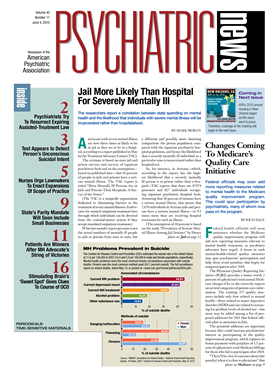Americans with severe mental illness are now three times as likely to be in jail as they are to be in a hospital, according to a report published in May by the Treatment Advocacy Center (TAC).
The estimate is based on state jail and prison surveys and surveys of inpatient psychiatric beds and on the assumption—based on published data—that 16 percent of people in jails and prisons have a serious mental illness. The TAC report is titled “More Mentally Ill Persons Are in Jails and Prisons Than Hospitals: A Survey of the States.”
(The TAC is a nonprofit organization dedicated to eliminating barriers to the treatment of severe mental illnesses. It advocates for assisted outpatient treatment laws through which individuals can be diverted from the criminal-justice system if they accept mandated outpatient treatment.)
What last month's report presents is not the actual numbers of mentally ill people in jails or prisons from state to state, but a different and possibly more damning comparison: the prison population compared with the inpatient psychiatric hospital population, and hence the likelihood that a severely mentally ill individual in a particular state is incarcerated rather than hospitalized.
So, for instance, in Arizona—which, according to the report, has the highest likelihood that a severely mentally ill person is in prison rather than a hospital—TAC reports that there are 47,974 prisoners and 827 individuals occupying inpatient psychiatric hospital beds. Assuming that 16 percent of inmates have a serious mental illness, that means that 7,676 individuals in Arizona jails and prisons have a serious mental illness—or 9.3 times more than are receiving hospital treatment for such an illness.
(The assumption of 16 percent is based on the study “Prevalence of Serious Mental Illness Among Jail Inmates” by Henry Steadman, Ph.D., and colleagues in the June 2009 Psychiatric Services.)
“I think there is no more important issue for psychiatry today,” Richard Lamb, M.D., a coauthor of the report and board member of TAC, told Psychiatric News. “The data demonstrate that there are many more people with severe mental illness in jails and prisons than in psychiatric hospitals. It seems that nobody cares—or at least that nobody is doing anything about it. The number of [hospital] beds continues to fall, and the prison population continues to climb.”
Lamb said that in Sonoma County, Calif., for example, the county board of supervisors has closed county mental hospitals and declared that severely mentally ill people who are living on the streets will be taken to jail. “This is slowly becoming the way that people with mental illness are dealt with,” Lamb said.
He has participated in a number of APA components including, most recently, as a member of the Committee on Jails and Prisons and as vice chair of the Council on Social Issues and Public Psychiatry.
For the United States as a whole, the TAC reports that 1,999,491 people are in jails and prisons. Using the 16 percent assumption, that means 319,918 of them have a serious mental illness.
But just 100,439 people with serious mental illness are occupying an inpatient psychiatric bed, so an individual with serious mental illness in the United States is 3.2 times more likely to be in jail than in a hospital, according to the TAC estimate.
The TAC report also found a correlation between spending on mental health and the ratio and the likelihood of incarcerating severely mentally ill individuals.
Applying statistical analysis to fiscal year 2002 data from a report by the National Association of State Mental Health Program Directors Research Institute, the TAC found that among the 10 states most likely to be using hospitals, six were also among the top spenders on mental health; conversely, among the 10 states mostly likely to have mentally ill individuals in jails and prisons, five were also among the states spending the least money per capita, according to the report.
The TAC offers several recommendations for how states can reverse the situation. They include the following:
•.
Assisted outpatient treatment that requires selected seriously mentally ill people to take medication under court order as a condition for living in the community.
•.
Mental health courts that give offenders a choice between agreeing and adhering to a treatment plan or going to jail.
•.
Unannounced state surveys by the Department of Justice or Institute of Medicine in each state could enumerate the number of seriously mentally ill people in jails and prisons and tie federal mental health block grant funding to the results by state.
•.
Repeal of the Medicaid Institute for Mental Diseases (IMD) Exclusion would provide for greater federal funding of treatment in the community. The IMD exclusion prohibits federal Medicaid matching funds from going to inpatient facilities with more than 16 beds whose patient roster is more than 51 percent people with severe mental illness. The policy dates from the enactment of Medicaid in 1965, when very large numbers of patients with mental illness were in state and local psychiatric hospitals already receiving public funds.
•.
Reforming treatment laws could make mental health treatment in the community based on need rather than dangerousness.
Lamb said, “We know what to do, but we don't have the funding, or else other priorities take precedence.”
APA past President Marcia Goin, M.D., who made the issue a prominent one during her presidency, said APA “has a long history of advocating for the just and rational treatment of the mentally ill—treatment, not incarceration.”
